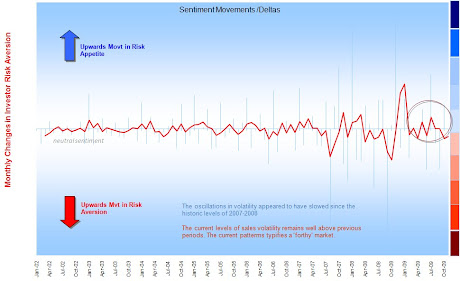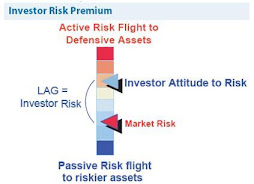Checklists, hedge funds and human behaviour (Nick Gogerty)
Nick Gogerty posted up an interesting note on the use of 'checklists'.. applicable to choosing active funds, passive etc..
http://nickgogerty.typepad.com/designing_better_futures/2010/01/checklists-hedge-funds-and-human-behaviour.html
"As a hedge fund guy and anthropologist, I am fascinated. Checklist dynamics applied correctly could be a hugely important innovation in group dynamics and increasing human potential. As a tool for facilitating group activity they appear to be incredibly effective. Read the book to understand how they work. It involves, group dynamics, social interactions, reducing cognitive load and a host of other things." Nick Gogerty, Fertilemind Capital
It's more developed than my simple logic grid approach; while sharing a similiar ethos, and worth thinking about. Of use to us guys is a re-think on how to diversify a portfolio at outset.
Quote of the day: "Great spirits have always found violent opposition from mediocrities. The latter cannot understand it when a man does not thoughtlessly submit to hereditary prejudices but honestly and courageously uses his intelligence." Albert Einstein (attributed)
What is the fuss with volatility.....
Re the movement of market returns - many believe they follow a geometric or exponential Brownian motion ('GBM') which is a continuous-time stochastic process in which the logarithm of the randomly varying quantity follows a Brownian motion, also called a Wiener process. It is used particularly in the field of option pricing because a quantity that follows a GBM may take any positive value, and only the fractional changes of the random variate are significant ('deltas').
http://en.wikipedia.org/wiki/Geometric_Brownian_motion
So in practice 'brownian motion' assumes a strong tendency to trend - it says that returns won't jump from day 1 to day 2 but move up and down in fairly predictable increments.. the returns of the previous days have an impact on the subsequent day - they are not unique. This estimation of how prices move is the underlying principal for the future pricing of derivatives contracts such as options.. i.e. E.g. to buy a contract, at one price, to buy or sell the underlying asset at a future date at a future price... this is usually referred to as the 'Black-Scholes formula' or the much much earlier Bronzin model (1908). This ties up with the old-age 'law of big numbers' (or law of averages) - where returns follow a pattern around a mean and that the volatility around that mean diminishes over time.. Where those returns are then assumed to form a normal distribution (or bell curve) then the 'GBM' is symmetrical to the mean of those returns. BUT what if we do not believe upside and downside returns will be similiar?.
A LOT of analysis has been run since to dispel this view such as many variations of the the Noble winner Robert Engle's ARCH approach in 2003 ('heteroskedasticity'.. or the analysis of different dispersions/volatilities), countless variations thereof, stochastic models (see below*), extreme loss analysis, stress testing, scenario analysis and so on - it keeps the Math boys busy shall we say...
*Stochastic models: treat the underlying security's volatility as a random process, governed by variables such as the price level of the underlying, the tendency of volatility to revert to some long-run mean value, and the variance of the volatility process itself, among others. Somtimes I use Markov chain as the easiest way to visualise and understand a random process: usually it's illustrated by the cat and the mouse:
Suppose you have a timer and a row of five adjacent boxes, with a cat in the first box and a mouse in the fifth one at time zero. The cat and the mouse both jump to a random adjacent box when the timer advances. E.g. if the cat is in the second box and the mouse in the fourth one, the probability is one fourth that the cat will be in the first box and the mouse in the fifth after the timer advances. When the timer advances again, the probability is one that the cat is in box two and the mouse in box four. The cat eats the mouse if both end up in the same box, at which time the game ends. The random variable K gives the number of time steps the mouse stays in the game..
This
Markov chain then has 5 states:
State 1: cat in the first box, mouse in the third box: (1, 3)
State 2: cat in the first box, mouse in the fifth box: (1, 5)
State 3: cat in the second box, mouse in the fourth box: (2, 4)
State 4: cat in the third box, mouse in the fifth box: (3, 5)
State 5: the cat ate the mouse and the game ended: F.
To show this for a fairly infinite number of price movements is somewhat less achievable but nonetheless that's what the clever bods have done..
Otherwise most of probability, I admit, is above my head unless it descends into some sort of practical application - BUT I get the sub-plot.. stop trying to predict future patterns from regressing past performance... show me the track record of a model (after it has been created) and I'll be one step closer to being converted.. I'll touch on stress testing, extreme analysis ('extremistan') and scenarios another day..
"The Black–Scholes model disagrees with reality in a number of ways, some significant. It is widely employed as a useful approximation, but proper application requires understanding its limitations -blindly following the model exposes the user to unexpected risk. In short, while in the Black–Scholes model one can perfectly hedge options by simply Delta hedging, in practice there are many other sources of risk." Wikpedia
http://en.wikipedia.org/wiki/Black%E2%80%93Scholes
The UK Investor - The Surprise Factor
The maps in the presentation (below) really help illustrate the suprise factor of the credit crunch.. little of the previous patterns would prepare the UK investor for what was about to come. The flows show that investors did not recognise the risks inherent in 2006-2008. This is because the industry uses conventional fund metrics, which were at best outputs not guides..!




Someone on one of the wealth forums asked: "Why stop at 10 questions there are only millions more to consider... (By the way... what good is asking these questions if no one can reliably answer them?)."
ReplyDeleteGood point - we all know very little of the world and the differences in what you and I know, relative to the total amount of available information, is infinitesimal. However the small degrees of variation in the way we use information, and decisions we make, has a large difference on our daily lives.
We use checklists to make information manageable and our decisions objective. This is why a set of 10 questions is better than a million. As humans we are not good at processing lots of unique information and drawing objective decisions from them. This is why some rely on algo programs to process the questions for them (big mistake). By ourselves, 10 we can do a little better.
We make information objective to make our decisions logical, by identifying and learning from errors. We're not so good at learning from the subjective or anecdotal. This is how we learn - trial and error - without which there would be less invention; less innovation, more inaction.
There is a nice little Mike Jordan quote that Taleb uses about 'losing'. The fewer the # of questions the more we have a fixed point to measure against when something unexpected occurs. The point is that we don't accept; we ask 'why' and probe gaps, we try to learn. Checklists can help.
"For the ordinary man is passive. Within a narrow circle he feels himself master of his fate, but against major events he is as helpless as against the elements. So far from endeavouring to influence the future, he simply lies down and lets things happen to him.." G. Orwell.